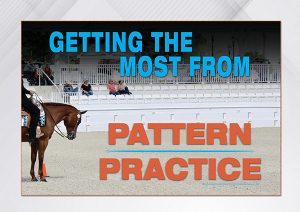Getting The Most From Pattern Practice
Click here to read the complete article
206 – March/April, 2023
Don Shula, the NFL’s most winningest head coach once said, “Strive for perfection, but settle for excellence.” His saying is one that many riders can relate to, knowing full well the sport involves having an animal over 1,000 pounds for a show partner and the simple fact that no matter how hard you train and no matter how well-trained your horse is, the ability to be perfect is just not a realistic objective.
Making one’s patterns excellent is no easy task, however, even though that is everyone’s goal. It takes a lot of multi-tasking abilities to practice patterns and show in the pattern classes, not to mention the countless hours spent at home and in the warm-up arena studying the ins and outs of how patterns should be executed. That’s in addition to learning what skills need to be implemented and practiced before ever stepping foot or hoof into the show pen.
So what strategies should you be utilizing at home to improve your patterns in the show ring so they are the best they can possibly be? Our experts assign homework strategies, share memorizing tips, and give advice on how to get the most out of any pattern practice. Their advice works for any age or level of rider.
Home School Drills
Professional horseman, judge, and trainer Dean Bogart of Dean Bogart Performance Horses of Monroe, Georgia, specializes in all-around horses and riders. Bogart says that one strategy riders should be utilizing when practicing pattern work at home is to walk, trot and lope in round circles and straight lines.
He says, “You’ll also want to vary circle sizes and gait speeds so you can travel from circles to straight lines. The goal is to be able to move easily from circles to lines and back again smoothly.”
Trainer Duke Williams of Duke Williams Performance Horses in San Marcos, Texas, focuses on all-around horses and events with the help of trainer Alyssa Casa. “Riders need to focus a little less on horse training and think more about what is going to help them succeed in patterns by learning how to ask their horse to perform each and every movement,” Williams states.
During practice pattern lessons, Williams has riders focus on all types of transitions, “Try for a smooth change with correctness rather than drilling maneuvers over and over and by themselves. Transitions are the key to having effortless maneuvers.”
Mindful Memory
Click here to read the complete article
206 – March/April, 2023











